 Research Article
Research Article
Cultural Work Instruments in Fashion Technology - Practical Method of Generating Emotional Design
Marlena Pop1*, Stefan Toma2, Nora Frigy1 and Alexandru Manuel Pop2
1National RDI Institute of Textile and Leather, Romania
2University of Art and Design, Romania
Marlena Pop, National Research and Development Institute for Textile and Leather, Bucharest, Romania.
Received Date: July 21, 2018; Published Date: August 16, 2018
Abstract
Clothing fashion technologies, from yarn to clothing, are some of the oldest cultural technologies of humanity, integrated into both the public and domestic space of life [1]. The artistic and cultural imaginary, predominantly feminine, has found an ideal place of expression, because the tradition of social and cultural praxis has a millenary individuality and continuity [2]. In the 21st century, in a context of globalization of economies and technologies, cultural technologies strike a discordant note because they work based on cultural icons, and specific societal imaginary [3]. In this field, Technical engineering, informatic (logic-mathematical) and cultural (cognitive-emotional) languages need to find a common denominator to respond to the complexity of consumers’ demands for modern products. Interdisciplinary approaches should not remain only at academic or technological level, transdisciplinary may be a holistic key to the success of some disciplines, in the context in which co-creation and collaborative design are nowadays common in leadership and user-oriented creation. Emotional design and art science have become increasingly attractive research directions in many interdisciplinary art programs that rely on the many novelties of science and technology, as well as the research of metaphor or visual semiotics. This is the academic world, but the reality of creative and cultural industries is much closer to crafts and a digital world that is used only as commercial support or product development. The article presents the laboratory verification, together with students, of a method of generating the emotional, practical design of product creation by using a mix of cultural instruments, a method substantiated by the main author of this article. The purpose of this practical method is to make creative individuals aware of the importance of cultural work instruments in fashion technologies.
Keywords: Cultural work instrument; Artistic imaginary; Emotional design; Fashion technology
Introduction
Generation after generation of young artists want to experience fashion as art, and as many generations of engineers and economists wonder about the purpose of each of these artists’ exercises. Some pursue perfection, or performance, others only want to understand the art of style, but only a few chosen can express a moment of civilization through aesthetics of style. Generations of people in fashion business have experienced fashion as the unifying aesthetic rule, fashion as an ideation for developing hedonistic buying behavior, or fashion as an expression of identity design. The development of design theories and scientific research in the last 10-15 years, and the design thinking and the typologies of this field, have also led to the humanistic approach of practice in fashion design and research of fashion [4]. New research directions have emerged in product design that contribute to a better understanding of both product and design, not only by the consumer, but also by the professional practice and research in design. Design research is innovation-oriented, by finding elements of attractiveness of the existing product, or by invention, by designing a product with new, original attributes. In both types of design research, specific work instruments are used that belong to classical, IT, or cultural technologies. The last years have been dominated by the interest of both designers and marketers, both in terms of revenue growth through design, but especially in terms of knowledge of the consumer’s needs in relation to the product, to its personalization techniques, and the awareness of creativity. Interactive design, UX design, Emotional design, Co-design, or Sustainable design are as many research directions in innovation design that led to the formation of research and training companies. Humanities for fashion is based on a specific aesthetic research. As Kawamura Y says, “fashion is the immaterial dimension of modern culture” [9] [5]. It is used in marketing as a working tool for understanding people’s relationship with creative and cultural objects. The relationship between product experience and values aesthetic is important in the context of cultural studies, “because implicit and explicit values are often seen as key determinants of culture” (see Williams, 1961). In this context, of articulating the human experience with the practical, more technical environment of design, if we want to understand emotional design as consumercentered practice, it is necessary to understand the content and the imaginative meaning of the design concept. Practically, by reading the aesthetics of design, by understanding the metaphor or visual metonymy, the aesthetic emotion is achieved, which gives the feeling of aesthetic pleasure. Hekkert P propose to restrict the term aesthetic to the pleasure attained from sensory perception, as opposed to anesthetic [6,7]. An experience of any kind, e.g., of an artwork, a product, a landscape, or an event, thus comprises an aesthetic part, but the experience as a whole is not aesthetic”. The purpose of this practical method is to make creative individuals aware of the importance of cultural work instruments in fashion technologies, which they use intuitively or as initial informational baggage. The approach of this experience with the students, which outlines a method of analyzing the content of the design project, is one required in current practice, because fashion humanist research must also be in the designer’s creative studio, not just in cultural studies.
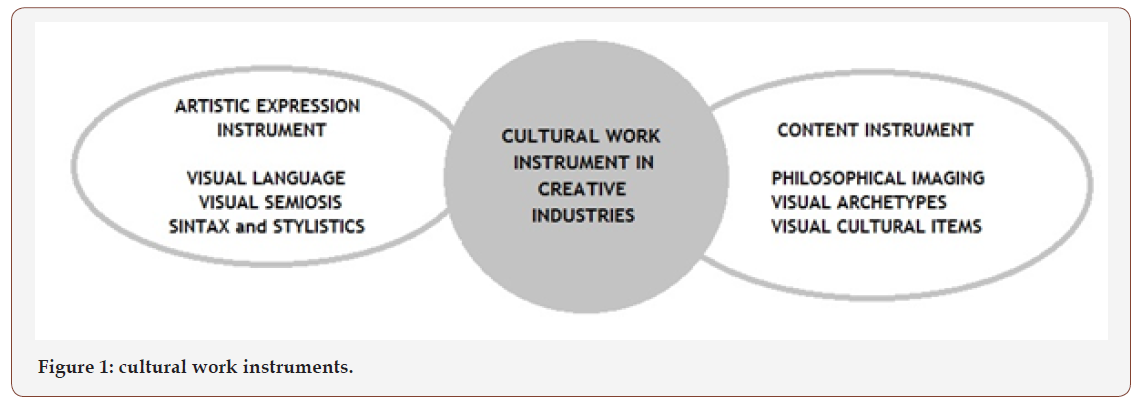
In the 21st century, thematization that has the role of synthesis, clarification of concepts and ideas, because “in the epistemes of our time, which have taken operationality very far, shifting the logic into mathematics, so that science has become more a process than a discourse, rather something to do than something to say, the meaningful provides a possibility of comprehending the real” (Codoban AT) from the semiotic point of view, the meaningful, through all signifying systems, is organized upon the structure of the language. “The logos of our world are based on coding-decoding, metaphor-metonymy, archetypal analogies and pertinent differences and everything is given in simultaneity (Codoban AT) [8]. In fact, both the artist and the art consumer, both the designer and the design consumer, must belong to the same symbolic universe for the work or product to be correctly received, assessed and considered valuable, both for the soul and the mind of everyone. In a more technical way, emotional design is necessary in the conceptualization of any type of product, for the simple reason that each of us, consumers of globalized civilization products, such as minimalist design, based only on functionality, feel it is not enough. Design based on a marketing story begins to stop working because the human being of today, living in an information society, wants more out of a product. In this context, the emotional design becomes not only a research object but also a work instrument in any kind of conceptualization of a modern product. The epistemological landmarks of this research call into question both theories of philosophical or artistic approach to the imaginary, as well as its monads” - the myth and archetype, which in turn express themselves through story, symbol or visual sign in the research of emotional design fashion. The theories on the philosophy of the imaginary show that the real-symbolic-imaginary triad is used as a starting point in any humanistic analysis, because these three elements represent the levels of the individual’s relation to the world. For literary and artistic imaginary analysis, imaginary research has developed a series of analytical tools: psychocriticism, myth criticism, archetypology, imagology, methods that allow hermeneutics of cultural imaginary from an immanent perspective that captures the irreducible specificity of the image, as psychological functions that have a well-defined status. The methods of approaching the imaginary are diverse, from structural semiotics, developed by linguistics and literary criticism, with its exceptional theorists like R. Barthes, G. Genette, A. Greimas, etc., to the symbolic hermeneutics represented by George Bachelard, Gilbert Durand, Paul Ricoeur, etc., and between the two a current inspired by psychoanalysis, first of all by CG Jung’s works, and now by J-J Wunenburger’s research, who said a few years ago that “the art crisis is perhaps a symptom of the difficulty of putting artistic imagination in its rightful place” (Wunenburger JJ) [4]. That is why through this fashion design project we assert that emotional design that uses theme-specific cultural instruments based on research of the imaginary can provide the consumer with a smart and sensitive product at the same time. Basically, this research project seeks, on the one hand, to identify the typology of the archetypal imaginary in fashion, and on the other hand, through laboratory experiments, intends to verify the integration mechanisms of the archetypal elements expressed by icono-plastic sign, identity sign and signsymbol in the sketches of ideas for future products. All these are generated by the cultural instruments used: international trends in fashion, philosophical, mythological or archetypal thematizations, and the awareness of personal ideation as a psycho-cultural work instrument. Cultural technologies in fashion design use content instruments as work instruments: philosophical imaging, visual archetypes and visual cultural items, also using cultural expression instruments that are defined by artistic language, with its own syntax and stylistics (Figure 1) [9].
The transversal actions of creation offered by visual language use both content codes and the aesthetic material basis, by means specific to visual language, as an instrument of cultural expression. Thus, ideation processes are obtained which bring new aesthetic elements both through innovation and through the creative diversity of aesthetic concepts. Transforming such an idea into a product concept involves transversal actions, stylistic declination and commercial (assortment) declination. Thus, through this design thought process, with the help of cultural instruments, a greater variety of cultural objects and creative products are developed, transforming the specific matter into an emotional and cultural product. In fashion design, cultural content instruments are:
Generic cultural instruments:
- Global, industrial trends
- Identity imaging (Figure 2)
- Market and consumption study [10]
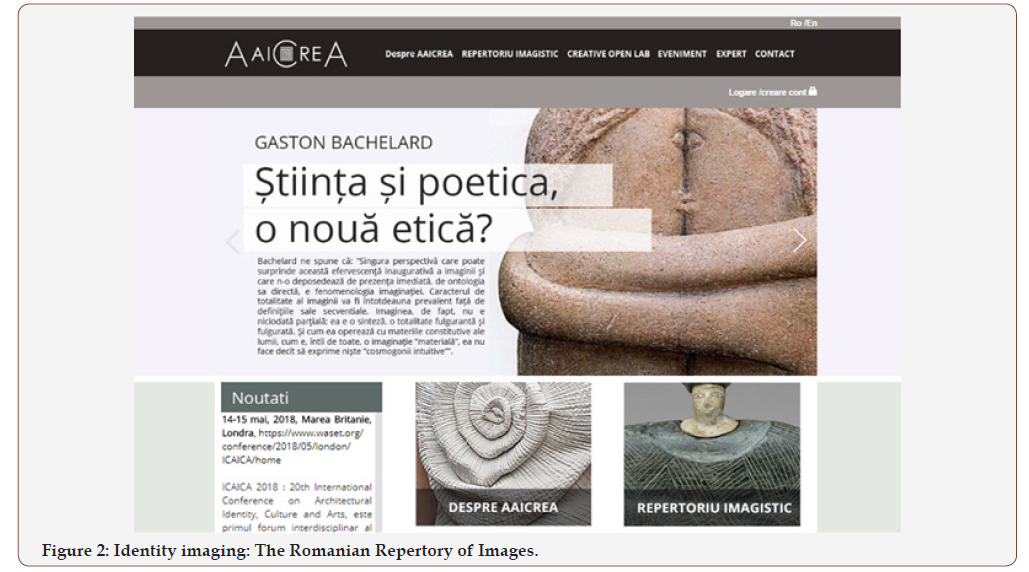
Specific cultural instruments:
- Cultural artistic trends in fashion
- Media and reference events
- Styling
Methodology
From the humanist practices in industry, such as semiotics, history, philosophy, psychology and the theory of different design practices and specific visual languages, the closest form of communication to any type of consumer, emotional design is centered on visual stylistics and semiotics. Among the general theoretical frameworks used so far in the development of emotional design, the most often used are those of Norman DA [11] who proposed three levels of pleasant experiences based on neurobiological emotion theory, and Hassenzahl, who proposed six positive experiences of clients in relation to the product. This type of emotional assessment, based only on antagonistic values, is not enough because it does not reveal the emotional content of the design. The mix of cultural instruments has the following theoretical framework: the evaluation of positive experiences only in relation to the product design, offering imaginative archetypes and the relation of the epic with the artistic expression of the product. Knowing that art by definition expresses emotion transmitted visually and in design, the artistic element of a design project must be linked to both the ideational product content and the visual language used, namely metaphor or visual metonymy to be in the same code speech with visual language. The cultural content instruments are defined by the thematic elements, and those of artistic expression in product design, by the semiotic ones, the metaphor and the visual metonymy. In order to develop a visual metaphor, or metonymy, the designer needs a general cultural instrument of synthesis to help him express and conceive the configuration of a new product. In order to implement the method of generating creation through the mix of cultural instruments, the method substantiated by the main author of this article, a training was carried out with all the students of the second year (2017) and third year of undergraduates (2018), from the University of Art and Design, Department of Fashion, Cluj Napoca, Romania. Explaining the role and importance of research in design, the structure of the method of generating creation through the mix of cultural instruments, and the methodology used to carry out the experiments generated many additional questions and explanations, which demonstrated young people’s need for knowledge. In general, the following aspects of the method were explained:
a. Definitions, types and cognitive schemes of research in the practice of art and design forthe fashion, clothing and textiles industry;
b. Structure of research in design and the process of its development in the stages of ideation and creation of the new product concepts - “Design Thinking” instrument;
c. The definition and types of cultural instruments used in product creation and design: international fashion trends, inclusive and identity thematizations, such as the Romanian Repertory of Images and awareness of personal creativity;
d. Definition, typology and examples of identity design;
e. What is, and which is the importance of the Romanian Repertory of Images as a cultural instrument for developing the cultural sustainability of modern Romanian products;
f. Experiment methodology that primarily seeks to use cultural content tools and perform transversal visual conceptual hybridization actions.
By explaining the stages of ideation and of conceptualization of the teams’ and individual project, it was easier to follow the steps of the method and work was more relaxed and continuous (Figure 3).
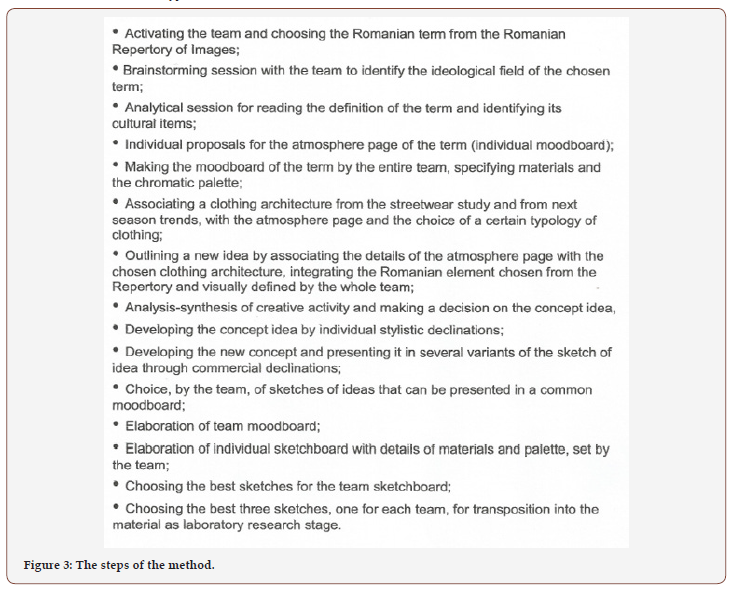
At the beginning of the project, three teams were formed, by drawing lots, each with 7 members. The teams chose a term from the Romanian Repertory of Images. Thus, team 1 chose the term “The Other Realm”, specific to Romanian fairy tales, team 2 chose the term “Column”, from Romanian architecture dominated by Brancoveanu column and Brâncusi column, and team 3 chose a character from Romanian fairy tales: “Shrew”. In order to reach the first creative ideation elements, members of each team worked together to define the chosen terms, find keywords and specific cultural items. After the entire design research activity conducted in May, during which over 240 individual sketches were drawn, out of which three were chosen for each student, three mood-boards and three team sketch-boards, an analysis session was held, and an evaluation committee was formed to assess results. Following analysis, it was not possible to choose the best sketch that could be transposed, which led to a compromise decision: making a sketch that is a hybrid of the best three final sketches, one for each team. The next week they were transposed into material. At the end of the ideation, product concept creation and development stage, students participated in a focus group to express their opinion on the influence of this method on their product design thinking. Through this exercise of experimenting with a research method in emotional design using cultural working tools, students have had the opportunity to get acquainted with product design concept research in fashion design, with its exigencies and the need to respond on time and within the requested quality parameters. It was also the first team work exercise of collaborative design, in the field of Romanian academic fashion design, to solve a field-specific research theme (Figure 4-6).
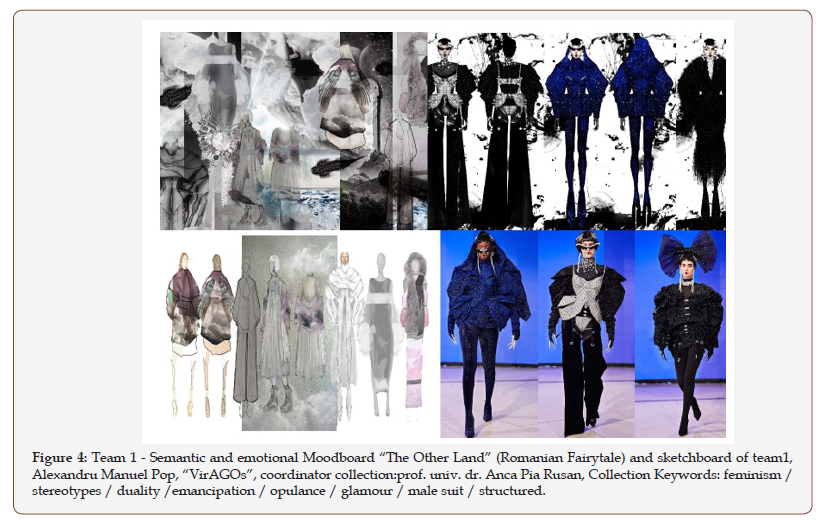

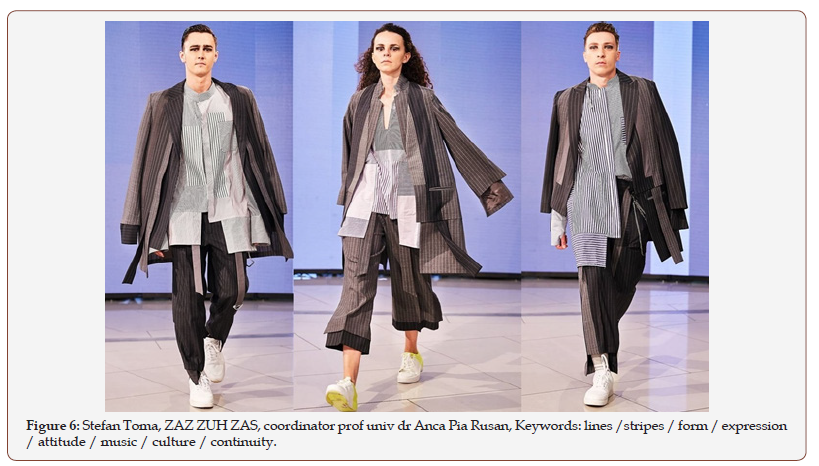
Results
Team I came up with a complex imaginative mood-board, which can be transposed visually by the ideological identity development of the Romanian fairy tale. It is the visual offer of an unlimited imagination, which shows the opening of the creative field. Each consumer can enter the story by creating an image of his own story. The dress design proposed by Alexandru Manuel Pop was identified with the negative element of the fairy tale emotion but, being in the story, it does not become too rough [12]. Stefan Toma has brought the story of chaos into practice, and Ana has transformed the Romanian textile column, the flock of wool, into a nomadic story of cultural identity. The three clothing designers have elements of emotional design in their works.
Conclusion
The mix of cultural tools method allows the designer to become aware of his own creativity and the context of the collaborative imaginative environment.
There has been a time-lag in drafting concept sketches and product concepts.
The knowledge base of students at any creative individual can be developed on the recommendation of the study or work environment of each person who implements the identity design method and development emotional design. It was also noted that collaborative design is more semantically, cognitively and emotionally charged than average individual design.
In addition, experiments have shown that the cultural sustainability of creative industries products will exist as long as the appropriate cultural instruments are used, both in terms of semiotic and semantic code, and aesthetic material resource.
This synthetic method of the mix of cultural instruments suggests the need for a deeper approach to typology of the synthesis elements required to develop an effective practice in emotional design, specific to fashion design [13].
The elements of visual semiotics, like metaphor and visual metonymy, require a thorough study conjugating the expression with the ideation of the content of a fashion project [14].
References
- Barnard M (2002) Fashion as Communication. Psychology Press. Language Arts & Disciplines, pp. 209.
- Bourdieu P (1984) Distinction: a social critique of the judgement of taste. Harvard University Press, USA, pp. 613.
- Haque NA, Alam JW, Mahmud H, Hasan (2014) Identifying emotion by keystroke dynamics and text pattern analysis, J Behav Info Technol 33(9): 987-996.
- Barthes R (1983) The fashion system. Hill and Wang, Newyork, USA, pp. 303.
- Kawamura Y (2005) Fashion-ology: an introduction to fashion studies. Eicher JB (Ed), Berg Publishers, Newyork, USA, pp.124.
- Desmet P, Hekkert P (2007) Framework of product experience. Intl J Des 1(1): 13-23.
- Hekkert P (2006) Design aesthetics: principles of pleasure in design. Psychol Sci 48(2): 157-172.
- Codoban A (2001) O introducere postmoderna in semiology si hermeneutica, Dacia editor, Cluj-Napoca, Romania, ISBN-9733510815.
- Pan Y, Roedl D, Blevis E, Thomas J (2015) Fashion thinking: fashion practices and sustainable interaction design. Int J Des 9(1): 53-66.
- Douglas M, Isherwood B (1996) The world of goods: towards an anthropology of consumption (2nd edn) Psychology Press, London, UK, pp. 169.
- Norman DA, Verganti R (2014) Incremental and radical innovation: design research versus technology and meaning change. Des Issues 30(1): 78-96.
- Pop M, Iuhas F, Borangic C (2016) Repertoriul Imagistic Roman, www. aaicrea.ro, ISBN 978-973-0-23249
- Tzou RN, Lu HP (2009) Exploring the emotional, aesthetic, and ergonomic facets of innovative product on fashion technology acceptance model. J Behav Info Technol 28(4): 311-322.
- Wilson E (2003) Adorned in dreams: Fashion and modernity. I B Tauris & Co Ltd, London, UK, pp. 344.
-
Marlena P, Stefan T, Nora F, Alexandru M P. Cultural Work Instruments in Fashion Technology - Practical Method of Generating Emotional Design. J Textile Sci & Fashion Tech . 1(1): 2018. JTSFT.MS.ID.000505.
-
Cultural work instrument, Fashion technology, Emotional design, Artistic imaginary, Civilization, Humanistic, Consumer’s, UX design, Aesthetic, Cultural studies, Epistemes, Metaphor-metonymy, Archetypal, Myth criticism, Methodology, Psychology, Semiotics, Clothing, Textiles industry, Design Thinking, Typology
-

This work is licensed under a Creative Commons Attribution-NonCommercial 4.0 International License.






